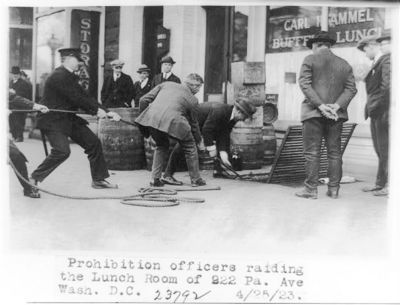Prohibition (United States)
The United States enacted Prohibition of alcoholic beverages with the Eighteenth Amendment to the Constitution and Volstead Act in 1920 under President Woodrow Wilson. During the period, the production, transportation, and distribution of alcohol were banned. Prohibition was supported by the Temperance Movement, politicians such as William Jennings Bryan, and groups such as the Ku Klux Klan. However, during this period a black market of alcohol flourished and encouraged the growth of violent gangs including Al Capone's. In 1933, the Twenty First Amendment was ratified and Prohibition was formally repealed.
Background
The brewing and consumption of alcoholic beverages have a long history in the United States tracing back to the early colonial era. However, in the late 19th century, the alcohol industry greatly expanded due to technological innovation, and establishments serving alcohol, called saloons, proliferated. The social problem of drunkenness soon rose, which caused a great amount of public concern. Organizations like Anti-Saloon League and Woman's Christian Temperance Union emerged to curb alcohol production and consumption. The movement against alcohol was known as the Temperance Movement. Important leaders of this movement include Frances E. Willard, Hannah W. Smith, Cary Nation and Wayne Wheeler.
The Prohibition Party was as a single-issue political party formed in 1869 advocating prohibition of alcohol, and still exists as a small party today.
Enactment
The sentiment of temperance soon reached the branches of government of the United States. In 1917, the Congress proposed an amendment to the Constitution to prohibit alcohol. The amendment was promptly ratified by 45 states in 394 days, and only one state, Rhode Island, voted to reject the amendment.[1]
The Eighteenth Amendment authorized the Congress and states concurrent power to enforce prohibition. In 1919, Congressman Andrew Volstead wrote the National Prohibition Act, known as the Volstead Act, to provide federal enforcement prohibiting the manufacture, transportation, and sales of beverages containing 0.5% or more alcohol.[2]
The President of the United States at that time, Woodrow Wilson, however, was not an ardent supporter of Prohibition. He vetoed the Volstead Act, but his veto was overridden by Congress.[3]
Implementation
In the early years of Prohibition, alcohol consumption did drop significantly. After that, however, it slowly increased, though never again reaced pre-1920 levels. Organized crime emerged in every large city, supplying bootleg whiskey and operating "speakeasies," often with payoffs to local officials. The most notorious gangster to profit from Prohibition was Al Capone of Chicago. The illegal alcohol distributed during Prohibition also posed a danger to consumers due to its frequently compromised quality, while the government lost tax revenues.
Revocation
In the 1930s, the national consensus in United States gradually shifted in favor of the repeal of Prohibition. In 1932, soon after the election of President Franklin Delano Roosevelt, the law was relaxed slightly to allow 3.2% of alcohol content in beer.[4] The Prohibition was formally abolished by the Twenty-first Amendment of the Constitution, proposed in 1933 and ratified by 38 states in 288 days, with only South Carolina voted against ratification.[1] This makes the Eighteenth Amendment the only repealed constitutional amendment in American history.[4]
Prohibition in fiction
The American novel The Great Gatsby by F. Scott Fitzgerald sets in the Prohibition era which the main character Jay Gatsby is a bootlegger and gained wealth by selling illegal alcohol.
Online sources
- Ohio State University College of Humanities, Temperance and Prohibition
- Prohibition Party, Spartacus Educational.
- David J. Hanson, National Prohibition of Alcohol in the U.S.
Bibliography
- Bader, Robert Smith. Prohibition in Kansas (1986),
- Behr, Edward, Prohibition: Thirteen Years That Changed America, 1997. ISBN 1559703946, popular history
- Blocker, Jack S. American Temperance Movements: Cycles of Reform (1989)
- Blocker, Jack S. Retreat from Reform: The Prohibition Movement in the United States, 1890–1913 (1976)
- Gould, Lewis L. Progressives and Prohibitionists: Texas Democrats in the Wilson Era (1973),
- Kerr, K. Austin. Organized for Prohibition: A New History of the Anti-Saloon League (1985), the major scholarly study
- Kobler, John, Ardent Spirits: The Rise and Fall of Prohibition, 1993, ISBN 030680512X, popular history
- Odegard, Peter H. Pressure Politics: The Story of the Anti-Saloon League (1928),
- Pegram, Thomas R. Battling Demon Rum: The Struggle for a Dry America, 1800–1933 (1998).
- Pegram, Thomas R. "Hoodwinked: The Anti-Saloon League and the Ku Klux Klan in 1920s Prohibition Enforcement." Journal of Gilded Age and Progressive era 7.1 (2008): 49 pars. online
- Szymanski, Ann-Marie. "Dry Compulsions: Prohibition and the Creation of State-Level Enforcement Agencies," Journal of Policy History 11 (Spring 1999): 115–46.
notes
- ↑ 1.0 1.1 Ratification of Constitutional Amendments, The U.S. Constitution Online
- ↑ Volstead Act, Spartacus Educational
- ↑ "No temperance in it…" Woodrow Wilson & the Prohibition Amendment, Woodrow Wilson House Exhibitions.
- ↑ 4.0 4.1 Repeal of Prohibition, Prohibition, the "Noble Experiment", April 14, 2005
